The Unique Charm of South Indian Homes: A Blend of Tradition and Modernity
A home is more than just a structure; it’s a sanctuary, a reflection of culture, and a haven that provides security and comfort against the elements. From the wild outdoors to unpredictable climate shifts, homes stand as our primary protector. Their design is profoundly shaped by the geographical zone, the availability of local materials, and the budget of the homeowner. Yet, in South India, homes possess an extraordinary uniqueness, deeply rooted in specific architectural styles, ancient traditions, and vibrant cultural influences.
The southern regions of India—comprising states like Kerala, Tamil Nadu, Karnataka, Andhra Pradesh, and Telangana—boast a rich heritage that translates beautifully into their domestic architecture. Unlike anywhere else, South Indian homes offer a fascinating glimpse into centuries-old customs and a thoughtful approach to living. If you’re curious to unravel the distinctiveness of these captivating dwellings, you’ve come to the right place. This exploration delves into the defining characteristics that make South Indian home designs not just unique, but also profoundly aesthetic and functional.
Architecture and Cultural Influence: Echoes of Heritage
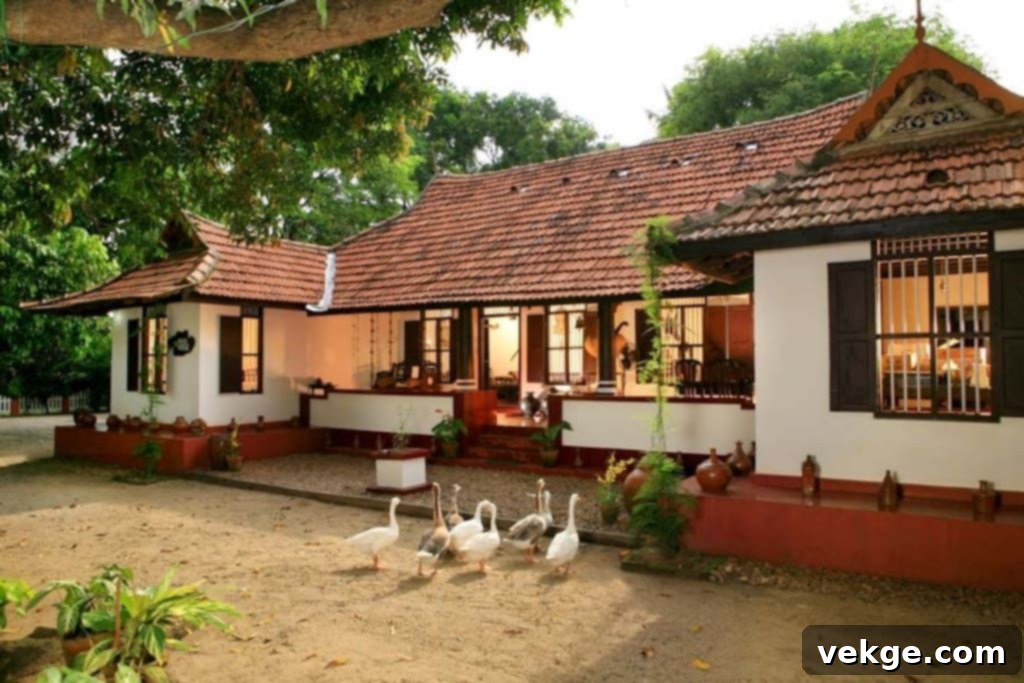
The architectural landscape of South India is a testament to its diverse cultural tapestry. Most home designs here are an intricate blend of regional specificities, state-level influences, and overarching cultural factors. Architectural carvings, often narrating mythological tales or depicting intricate floral and geometric patterns, have always been an integral part of Indian construction, and South Indian homes beautifully showcase this tradition. These detailed embellishments aren’t just decorative; they are storytellers carved in wood and stone, reflecting the artistic prowess and spiritual beliefs of the region.
Regional Architectural Marvels
As you traverse the southern states, distinct architectural styles emerge. In Kerala, the iconic *Nalukettu* houses, characterized by their central open courtyard and sloped tiled roofs designed to combat heavy monsoon rains, stand as masterpieces of vernacular architecture. These homes are typically constructed from wood and laterite, offering excellent natural ventilation. Tamil Nadu boasts the opulent *Chettinad* mansions, known for their grand entrances, spacious courtyards, imported European tiles, and exquisite woodwork, often influenced by European and East Asian aesthetics, while still retaining a distinct Tamil character. Karnataka’s traditional *Ainmanes* or *Guthu Mane* often feature elaborate wooden pillars and central courtyards, serving as ancestral homes for joint families.
A key aesthetic principle in these designs is the emphasis on earthy tones. These natural hues, derived from local materials like terracotta, laterite stone, and various types of wood, create a warm, inviting, and naturally aesthetic environment. The traditional architectural patterns and influences are most prominently displayed in key structural elements: the main doors, floors, roofs, and windows. Front doors, for instance, are often elaborate statements, adorned with intricate wooden carvings or traditional motifs that elevate their beauty and curb appeal, acting as a welcoming portal into the home’s soul.
The differences observed as you move from Kerala to Tamil Nadu or Goa are subtle yet significant, stemming from the unique cultural nuances and regional influences prevalent in each South Indian state and its communities. Each region, while sharing a broader South Indian identity, has cultivated its own distinct architectural vocabulary, making every home a unique narrative. For a deeper dive into traditional Indian houses across various regions, we invite you to explore our previous blog post on this fascinating topic.
Vastu Shastra Influence: Harmony in Design
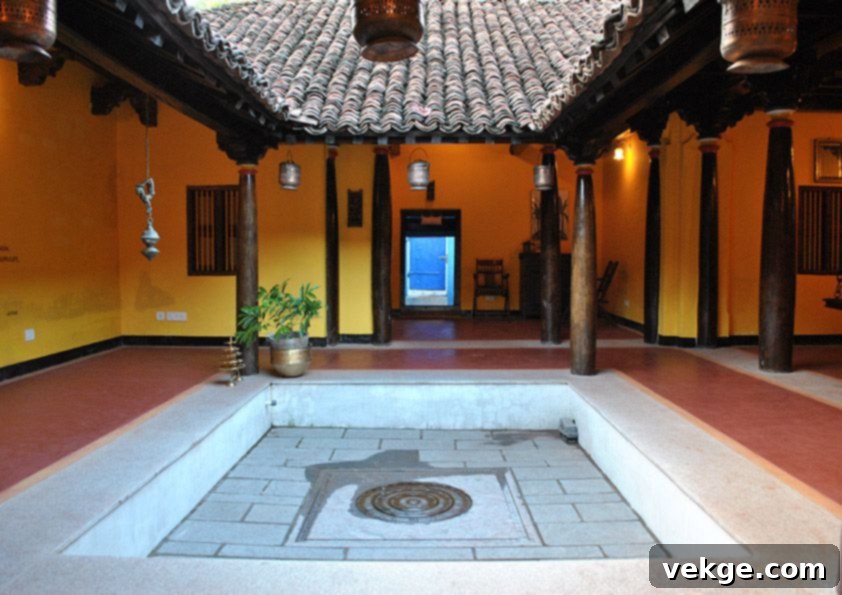
In India, the ancient science of architecture, known as *Vastu Shastra*, profoundly influences the design and construction of numerous traditional buildings, including homes. This age-old system, translating to “science of architecture,” provides guidelines on how to build in harmony with nature and cosmic energies, promoting prosperity, health, and peace for residents. It’s not uncommon for people, irrespective of their socio-economic background, to consult *Vastu* principles when designing or renovating their homes.
The adherence to *Vastu Shastra* dictates various aspects of home construction, from the orientation of the house relative to cardinal directions to the placement of specific rooms. For instance, the kitchen is often placed in the southeast, associated with the fire element, while the prayer room (or *puja* room) is ideally located in the northeast, considered the most auspicious direction. Master bedrooms are typically positioned in the southwest. This meticulous planning, guided by *Vastu*, brings a common pattern of thoughtful space allocation and energy flow in South Indian homes, distinguishing them from residences in other parts of the world.
Beyond structural layout, *Vastu Shastra* also influences the home’s decor, the availability and utilization of space, and even the external architectural design. This adherence adds a distinct flair of uniqueness, ensuring that the home is not just aesthetically pleasing but also a wellspring of positive energy. The integration of *Vastu* principles creates living spaces that are not only comfortable and functional but also resonate with spiritual harmony, making these homes truly special.
Elements and Furniture: Crafting Natural Elegance
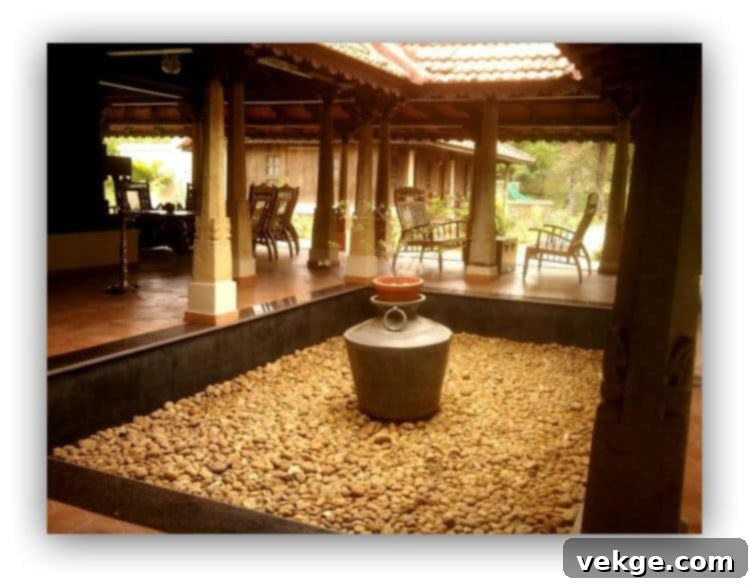
The interior design of South Indian homes derives its unique character from a thoughtful selection of elements and furniture, deeply influenced by local availability and traditional preferences. The predominant material for furniture is wood, celebrated for its durability, natural beauty, and the intricate craftsmanship it allows. From sturdy dining tables and ornate chairs to elaborately carved bed frames and storage units, wooden furniture is a cornerstone of South Indian interiors, often made from local varieties like teak, rosewood, and mango wood, each offering unique grains and tones.
When it comes to metals and crucial decorative elements, brass holds a place of honor. Beyond its aesthetic appeal, brass is traditionally considered auspicious and is widely used not just for decorative items like lamps, idols, and ornate handles, but also for everyday utensils. It’s common to find brass pots and plates used for cooking and serving daily meals, reflecting a blend of functionality, tradition, and belief in the metal’s health benefits.
The integration of nature is another hallmark that makes South Indian homes truly special. Wooden elements and furnishings bring the warmth of the forest indoors. Earthen elements, such as terracotta tiles or pottery, connect the living space to the earth. Furthermore, the presence of living plants within home boundaries, in courtyards, or on balconies, is not merely decorative but integral to the home’s ambiance. These green spaces foster natural ventilation, provide shade, and create a serene, refreshing atmosphere, enhancing the overall well-being of the inhabitants. Open-to-sky courtyards (*nalukettu* or *anganam*) are quintessential, allowing natural light and air to permeate the core of the home while also serving as communal spaces for family gatherings and rituals.
Trends and Modern Influence: Evolving Traditions
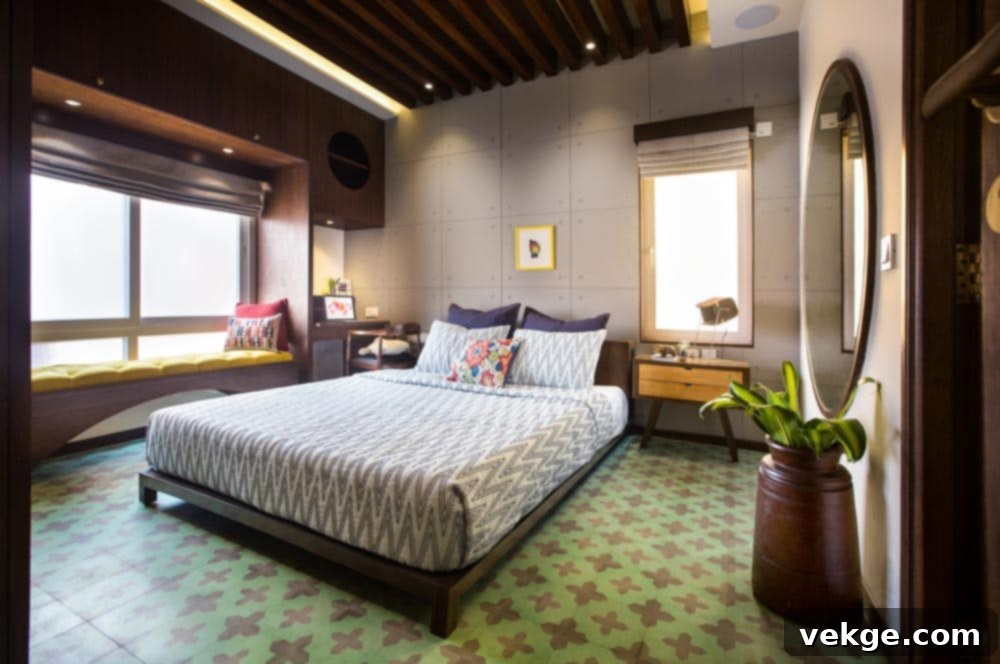
While traditions are deeply embedded in the roots of Indian culture and permeate every aspect of life, including homes and buildings, contemporary trends are undeniably shaping architectural and interior design. As time evolves, homeowners are embracing modern designs and themes, carefully integrating them into their traditionally and culturally rich homes without sacrificing their heritage.
This evolving approach doesn’t imply a complete abandonment of tradition; rather, it’s a conscious and careful blending of traditional elements with modern influences. The goal is to preserve the rich cultural identity while simultaneously enhancing architectural designs with contemporary comforts and aesthetics. This harmonious fusion often results in spaces that are both deeply traditional and refreshingly modern.
You can observe this fascinating combination in various forms: minimalist approaches might be paired with classic interior elements, false ceilings can incorporate traditional motifs or lighting fixtures, and modern dining rooms might feature antique wooden furniture. Contemporary balconies offer sleek lines, while traditional courtyards are maintained as central features. Open-plan living spaces, smart home technologies, and contemporary art often coexist with intricately carved wooden pillars, traditional artifacts, and indigenous art forms.
Crucially, even within these modern adaptations, the essence of South Indian homes — the use of earthy tones and wooden furnishings — persists. These foundational elements are so beautifully blended with contemporary themes that it becomes challenging to separate the traditional influences from the modern. The result is a unique aesthetic that respects its past while confidently stepping into the future, offering the best of both worlds in South Indian home design.
Decoration and Color Palette: A Symphony of Hues and Details
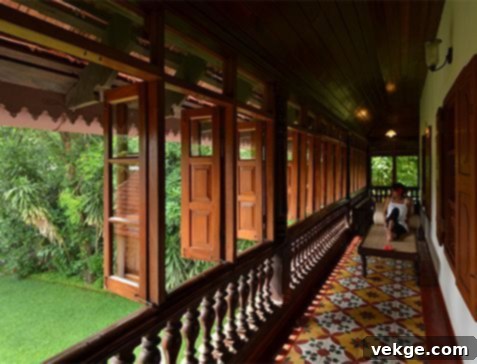
The decorative aspects of South Indian homes are characterized by a special touch, featuring carvings and artistic elements in various forms. Wall decor often includes traditional paintings, frescoes, or even contemporary art that complements the home’s aesthetic. Ceiling hangings, ornate ceiling lamps, framed pictures of deities or ancestors, traditional swings (*oonjal* or *jhula*) in living rooms, elegant curtains, and intricately framed mirrors are all commonly utilized to enhance the beauty and warmth of the living spaces.
Beyond natural light, which is always prioritized, trendy and decorative lights are strategically employed in rooms that may not receive sufficient daylight, creating an inviting ambiance. Since South Indian homes are significantly influenced by *Vastu Shastra*, the *puja* room or temple holds a sacred and special place. Depending on available space and the homeowner’s devotion, this can range from beautifully carved wooden wall-mounted temples to dedicated small rooms. These spaces are often elaborately decorated, featuring intricate carvings, traditional paintings on the walls, and vibrant floral arrangements, becoming a focal point of spiritual life within the home.
The walls and doors throughout the home are frequently adorned with beautiful carvings or artistic paints, reflecting regional art forms like *Kolam* (rangoli) at entrances. For the boundaries of the home or balconies, many prefer open, airy designs using wooden or iron panels, allowing for both security and ventilation. These boundary walls are often decorated with carvings, be they wood or metal, creating a mixed view – secure enough to define the property yet open enough to allow air and light to pass through, seamlessly connecting the indoor and outdoor spaces.
Color Palette: Earthen Hues and Vibrant Accents
The predominant color palette in South Indian homes is inspired by nature, featuring warm, earthy tones. Shades of terracotta, beige, cream, and deep wood tones form the base, creating a calming and grounded atmosphere. These natural colors are often complemented by vibrant accents found in textiles, traditional artwork, and decorative items. Rich hues like saffron, turmeric yellow, emerald green, and deep indigo are used in cushions, curtains, upholstery, and *Kolam* designs, adding pops of color that reflect the region’s lively culture and festivals. The combination creates a visually harmonious and stimulating environment that feels both traditional and incredibly inviting.
Final Thoughts: Embracing a Timeless Legacy
South Indian homes are a captivating mosaic, influenced by a confluence of profound architectural designs, ancient *Vastu Shastra* principles, rich Indian traditions, and deep cultural and historical influences. This powerful blend creates a unique and enduring design identity that stands apart. This exploration has highlighted the multifaceted reasons and factors that contribute to the distinctive aesthetic and structural integrity of traditional South Indian homes – residences that are not only beautiful but also inherently strong and thoughtfully designed for harmonious living.
From the grandeur of *Chettinad* mansions to the serene practicality of *Nalukettu* homes, each dwelling tells a story of heritage, adaptation, and an unwavering connection to nature. The meticulous craftsmanship, the sacred geometry of *Vastu*, the celebration of natural materials, and the graceful integration of modern elements all converge to create living spaces that are both timeless and relevant. These homes are more than just buildings; they are living testaments to a rich cultural legacy, offering a profound sense of belonging and well-being to their inhabitants.
If you’re inspired to add similar value to your life and home, or wish to delve deeper into home styling, decor ideas, and architectural insights, we encourage you to stay connected. Sign up for our newsletter to receive our best tips, strategies, and exclusive content directly in your inbox, helping you transform your living space into a reflection of beauty, tradition, and personal comfort.